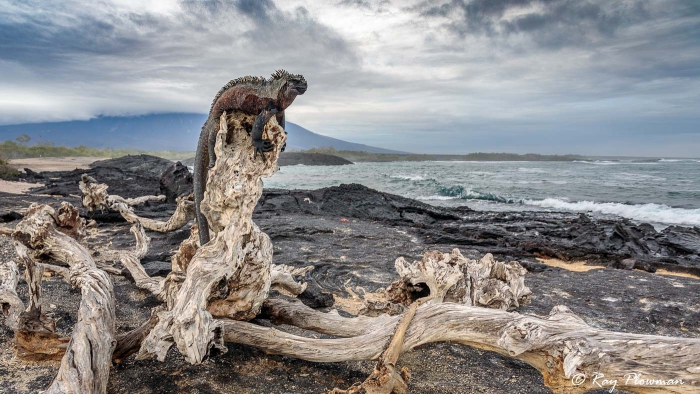Fernandina – Punta Espinosa
We anchored on the sixth day at Fernandina – Punta Espinosa after an overnight voyage from Tagus Cove.
Fernandina is the third largest, youngest, most active, and westernmost island of the Galápagos. It has the most pristine island ecosystem, and precautions are in place to exclude invasive species. Furthermore, La Cumbre Volcano lava fields reach the ocean, the rock is black, and the beach has coarse black sand.
Before breakfast, we made a dry landing for a short walk around the small peninsula. It has spectacular rugged seascapes with marine wildlife.

Marine Iguana on driftwood at Fernandina’s Punta Espinosa
A marine iguana on driftwood at Fernandina’s Punta Espinosa rugged north coast.

A Mess of Galapagos Marine Iguanas at Punta Espinoza
Marine iguana on Fernandina and Isabela are the nominate species of Amblyrhynchus cristatus. They are one of the largest subspecies but not the most colourful. Furthermore, colour changes with age. The young are black, while nominate species adult males are yellow and grey while females/juveniles are dark. Also, males are much larger than females, and Fernandina has the largest population in the Galápagos.
Fernandina – Punta Espinosa Landscapes and Wildlife
[foogallery id=”17086″]
Fernandina – Punta Espinosa Wildlife
A circular trail follows the small peninsula from the dry landing dock taking about one and half hours. I spotted a Galápagos Hawk perched in a tree at the edge of the mangroves. Albeit at a long distance, I managed to get a photo. No surprise to see the hawk considering the plethora of marine iguanas in the area. Also, Galápagos sea lions, a flightless cormorant, a male yellow warbler, American oystercatcher and a sally lightfoot crab. I also photographed ruddy turnstone but have not included them in the gallery. And, finally, an image of whale bones and a photo of the rough sea on the northern coast. The latter shows Isabela Island in the background. After the walk, we returned to the boat for a late breakfast.
Bibliography – Online Resources
1. Smithsonian Institution National Museum of Natural History Global Volcanism Program 2013. Online] Available from Smithsonian Institution National Museum of Natural History [Accessed 18-Sep-21].